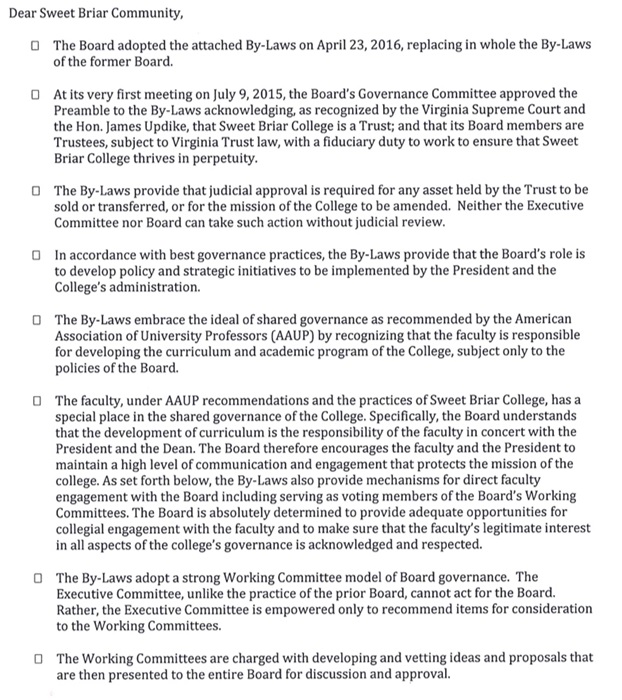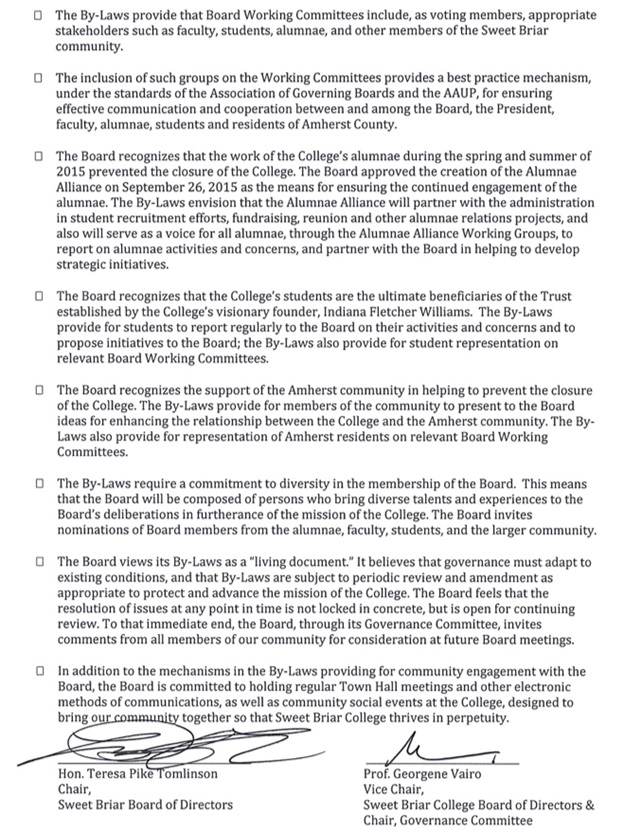
As NPQ readers may remember, Sweet Briar College almost closed a year ago after the board decided that it was ready to throw in the towel. Faced with declining revenues and a keening from the field about the impending demise of small, single-sex colleges, the board gave up after a few false starts at trying to reorganize. The decision came as a surprise to the students, the faculty, and the county of Amherst, Virginia, where the school was situated. Apparently, it did not account for the enormous fidelity and energy that surrounded the institution in the form of dedicated alumnae, many of whom were now mature, accomplished, professional women with mad skills and connections of their own.
Over a period of five months, the alumnae organized with faculty, students, and Amherst. They won a court case allowing the institution to move forward under a new board, even while meeting and exceeding all of the financial and other requirements set by the court. But how this all got done was the truly phenomenal part. The community took to social media and every other forum available to communicate each advance, discovery, and disappointment. It mobilized and essentially established a new governance system that refused to be denied.
Once it had wrested control away from a board that had no faith in the future of the college, the new board needed to demonstrate clearly that it was a different kind of governing body—one which recognized that the power of the stakeholders to revolt when necessary could also be the power to sustain. But shifting from revolution mode to sustenance mode required clear new governance practices from this board.
We have covered some of the ways the board approached the engagement of the alumnae network in previous articles, but here we want to share with you the changes the new board has made to their governing by-laws. We think they are important because they embody a set of learnings this system had about how to engage supporters in the creation of a vibrant and assured future.
Sign up for our free newsletters
Subscribe to NPQ's newsletters to have our top stories delivered directly to your inbox.
By signing up, you agree to our privacy policy and terms of use, and to receive messages from NPQ and our partners.
The changes laid out in the summary below speak to the dangers of an executive committee with too much power and to the benefits of enlisting the intelligent support of its natural networks. Our purpose in sharing them is to allow you to consider how your board might create some of the same kinds of systems of inclusion to build a stronger and more protected organization.


These points mirror an analysis by Mark Jones of The Pulse, reinforcing the critical importance of engagement of stakeholders and it is a great general reminder for all nonprofits with constituencies that can be mobilized. I shortened Jones’s points here and changed the word “alumni” to “stakeholders” (wherever you see bolding), but the column is worth reading in the original.
- Stakeholders/constituents can and should be integral partners in advancing our institutions: While the utility of our graduates is often measured solely by their financial contributions, philanthropic support is only one way that alumni can engage with and support our mission, goals and needs: They can also help identify and recruit future students, provide advice and counsel to our leaders, offer career guidance to current and former students, sponsor internships, participate in lobbying activities, and participate in a range of other volunteer programs. And as institutions that have done this effectively, if you engage alumni via these other avenues, their strengthened connections to their school tends to eventually prompt greater financial support.
- When we marginalize, dismiss or ignore our stakeholders/constituents, we do so at our own peril.
- For constituents to be true partners, we must keep them informed—and do so with both truth and candor: A colleague of mine often says, “If you keep people in the dark, their natural response is to imagine the worst.”
- If constituents don’t know about our challenges and needs, they can’t help us with them.
- To achieve full constituent engagement, we must take the initiative to invite them to the table: Constituents should have opportunities to shape the future of their institutions.
- Beware of creating “insiders” and “outsiders” among our constituents.
- A focus on mega-gifts donors can marginalize those who aren’t: Our growing reliance upon “mega-gifts” and the efforts to cultivate those who can make them may be exacerbating the divide between “insiders” and “outsiders.”
- Keeping promises matters.
- Self-perpetuating boards become insular and lose touch with other stakeholders.
- Stakeholder/constituent engagement and fundraising are not spigots that can be turned on and off at will.
- Stakeholder/constituent engagement and fundraising programs are more like huge heavy flywheels: In his celebrated 2001 book, Good to Great, Jim Collins employed the metaphor of an enormous, stationary flywheel (one he described as 30 feet in diameter, weighing 5,000 pounds, and rotating on a two-foot-thick axle) to explain the level of effort, patience and persistence necessary to transform an organization. Collins noted that it takes substantial initial force and exertion to get the metaphorical flywheel to move, as well as consistent application of energy in one direction over time to build real momentum and to ultimately achieve a breakthrough.
- Building powerful, productive constituent engagement and fundraising programs takes time: If we want to realize truly effective, productive and transformative results in our alumni programs and our fundraising efforts, we have to make adequate strategic investments in those programs, exercise patience and allow time for them to take develop, and never take our foot off the pedal once we achieve the outcomes and momentum we are seeking.











